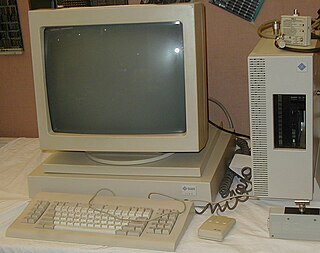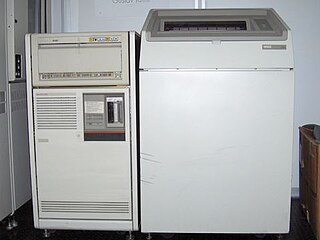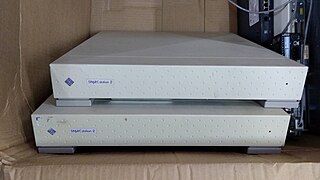In computing, cross-platform software is computer software that is designed to work in several computing platforms. Some cross-platform software requires a separate build for each platform, but some can be directly run on any platform without special preparation, being written in an interpreted language or compiled to portable bytecode for which the interpreters or run-time packages are common or standard components of all supported platforms.

SBus is a computer bus system that was used in most SPARC-based computers from Sun Microsystems and others during the 1990s. It was introduced by Sun in 1989 to be a high-speed bus counterpart to their high-speed SPARC processors, replacing the earlier VMEbus used in their Motorola 68020- and 68030-based systems and early SPARC boxes. When Sun moved to open the SPARC definition in the early 1990s, SBus was likewise standardized and became IEEE-1496. In 1997 Sun started to migrate away from SBus to the Peripheral Component Interconnect (PCI) bus, and today SBus is no longer used.

The SPARCstation 1 is the first of the SPARCstation series of SPARC-based computer workstations sold by Sun Microsystems. The design originated in 1987 by a Sun spin-off company, Unisun, which was soon re-acquired. The SPARCstation 1 has a distinctive slim enclosure and was first sold in April 1989, with Sun's support ending in 1995.

QEMU is a free and open-source emulator. It emulates a computer's processor through dynamic binary translation and provides a set of different hardware and device models for the machine, enabling it to run a variety of guest operating systems. It can interoperate with Kernel-based Virtual Machine (KVM) to run virtual machines at near-native speed. QEMU can also do emulation for user-level processes, allowing applications compiled for one architecture to run on another.

The Sun Ray was a stateless thin client computer aimed at corporate environments, originally introduced by Sun Microsystems in September 1999 and discontinued by Oracle Corporation in 2014. It featured a smart card reader and several models featured an integrated flat panel display.

The SPARCstation, SPARCserver and SPARCcenter product lines are a series of SPARC-based computer workstations and servers in desktop, desk side (pedestal) and rack-based form factor configurations, that were developed and sold by Sun Microsystems.

The SPARCstation 20 or SS20 is a discontinued Sun Microsystems workstation introduced in March 1994 based on the SuperSPARC or hyperSPARC CPU. It is one of the last models in the SPARCstation family of Sun "pizza box" computers, which was superseded by the UltraSPARC design in 1995.

The SPARCstation 10 is a workstation computer made by Sun Microsystems. Announced in May 1992, it was Sun's first desktop multiprocessor. It was later replaced with the SPARCstation 20.

SPARCstation 5 or SS5 is a workstation introduced by Sun Microsystems in March 1994. It is based on the sun4m architecture, and is enclosed in a pizza-box chassis. Sun also offered a SPARCserver 5 without a framebuffer. A simplified, cheaper version of the SS5 was released in February 1995 as the SPARCstation 4. Sun also marketed these same machines under the "Netra" brand, without framebuffers or keyboards and preconfigured with all the requisite software to be used as web servers. An estimated 400,000+ SPARCstation 5s were sold.
Sun-4 is a series of Unix workstations and servers produced by Sun Microsystems, launched in 1987. The original Sun-4 series were VMEbus-based systems similar to the earlier Sun-3 series, but employing microprocessors based on Sun's own SPARC V7 RISC architecture in place of the 68k family processors of previous Sun models.

Sun-3 is a series of UNIX computer workstations and servers produced by Sun Microsystems, launched on September 9, 1985. The Sun-3 series are VMEbus-based systems similar to some of the earlier Sun-2 series, but using the Motorola 68020 microprocessor, in combination with the Motorola 68881 floating-point co-processor and a proprietary Sun MMU. Sun-3 systems were supported in SunOS versions 3.0 to 4.1.1_U1 and also have current support in NetBSD and Linux.

The Sun386i is a discontinued hybrid UNIX workstation/PC compatible computer system produced by Sun Microsystems, launched in 1988. It is based on the Intel 80386 microprocessor but shares many features with the contemporary Sun-3 series systems.
The Cray Superserver 6400, or CS6400, is a discontinued multiprocessor server computer system produced by Cray Research Superservers, Inc., a subsidiary of Cray Research, and launched in 1993. The CS6400 was also sold as the Amdahl SPARCsummit 6400E.

The MicroVAX is a discontinued family of low-cost minicomputers developed and manufactured by Digital Equipment Corporation (DEC). The first model, the MicroVAX I, was introduced in 1983. They used processors that implemented the VAX instruction set architecture (ISA) and were succeeded by the VAX 4000. Many members of the MicroVAX family had corresponding VAXstation variants, which primarily differ by the addition of graphics hardware. The MicroVAX family supports Digital's VMS and ULTRIX operating systems. Prior to VMS V5.0, MicroVAX hardware required a dedicated version of VMS named MicroVMS.

The SPARCstation 2, or SS2 is a SPARC workstation computer sold by Sun Microsystems. It is based on the sun4c architecture, and is implemented in a pizza box form factor.

The Ultra 1 is a family of Sun Microsystems workstations based on the 64-bit UltraSPARC microprocessor. It was the first model in the Ultra series of Sun computers, which succeeded the SPARCstation series. It launched in November 1995 alongside the MP-capable Ultra 2 and shipped with Solaris 2.5. It is capable of running other operating systems such as Linux and BSD.

AMD Lance Am7990 IEEE 802.3 Ethernet media access controller (MAC) controller were introduced in 1985. Its architecture is the basis for AMD's PCnet Family of highly integrated single-chip Ethernet controllers. The one exception is the Am79C940 MAC. The Am7990 chip was fabricated in NMOS technology and has no integrated Manchester encoder/decoder (ENDEC) nor does it have an integrated 10BASE-T transceiver.

The SPARCstation IPX is a workstation that was sold by Sun Microsystems, introduced July 1991. It is based on the sun4c architecture, and is enclosed in a lunchbox chassis.
The Ultra 60 is a fairly large and heavy computer workstation in a tower enclosure from Sun Microsystems. The Ultra 60 was launched in November 1997 and shipped with Solaris 7. It was available in several specifications.















